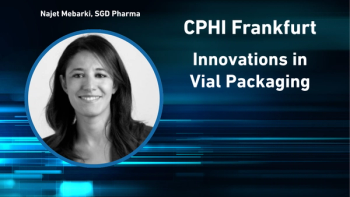
Equipment and Processing Report
- Equipment and Processing Report-04-19-2017
- Volume 10
- Issue 5
Equipment and Systems for Serialization Displayed at INTERPHEX 2017
Exhibitors focused on helping pharmaceutical manufacturers comply with upcoming DSCSA serialization deadlines.
Although the Drug Supply Chain Security Act (DSCSA) doesn’t require aggregation this year, “90% of the generics market wants to aggregate at least to the case, if not the pallet level,” Christopher Mueller, project engineer at Mettler-Toledo Vision Inspection PCE, told Pharmaceutical Technology in an interview at INTERPHEX 2017. “They want the supply chain advantages aggregation brings,” he explained. Having data about where product ultimately meets patient helps determine if marketing efforts are successful and helps combat counterfeiting and diversion. At INTERPHEX 2017 (Mar. 21–23, New York), several exhibitors focused on helping pharmaceutical manufacturers comply with upcoming serialization DSCSA deadlines.
Software and systems
Optel Vision and Adents chose INTERPHEX for major product launches. Adents introduced Adents Prodigi enterprise-level serialization and traceability software (see Figure 1). Based on Microsoft Azure Cloud technology and supported by tools such as OEE Tracker and Supplier Portal from Supply Chain Wizard, the software not only helps firms comply with regulatory requirements, but also organizes serialization data to provide useful business intelligence. The Adents Prodigi software securely generates or imports serial numbers in accordance with regulatory requirements, collects serialization data, manages data transfer between sites, and provides a simple interface between trading partners.
Optel Vision presented its new Fast Series preconfigured products for serialization and aggregation. With a delivery turnaround as short as six weeks, the Fast Series provides options for manual, semiautomatic, and fully automated lines. Options include a compact Manual Print Station, which prints and inspects serialized labels and can serve multiple packaging lines; the PackStation FMP manual packing station; the PackStation SAP semiautomatic packing station; the portable Offline LabelTracker for label inspection, verification, and commissioning; and the CLTracker TE automated carton label serialization unit. Designed to be integrated on carton labelers, the CLTracker TE unit also imparts tamper-evident protection. Fast Series installations encompass hardware as well as software, installation and operational qualification documentation, operator manual, and integration and on-site training services.
Another standardized serialization solution ready for quick delivery, the Antares Vision Quick Compliance Program from Antares Vision also supplies hardware, software, documentation, and services. Ready-to-ship modules include the Reel 2 Reel off-line label printing station, a manual packing station, and the Print & Check EVO Ready carton serialization system. The latter prints and checks serialized codes on carton flaps at speeds up to 300 units per minute.
Mettler Toledo offers a standalone carton serialization station as well as kits to retrofit existing labelers and cartoners for serialization. As cases are filled, onboard software compares the serialized code on each carton and cross references it with the database to verify the number is valid and commissioned. When the final layer is complete, the system confirms the case is full and prints a global trade item number (GTIN) label for the case. Labels for partial cases are printed with a serial shipping container code. A similar process is followed to build pallets. Scanning a pallet label reveals the codes of all cases on the pallet, as well as the cartons in each case, so shipments can be checked without depalletizing or opening boxes.
Another system that supports aggregation, the Navstar from ACG North America, provides 360-degree inspection of 2D codes. A cantilever design simplifies integration on bottling lines. A single dial adjustment provides easy and reproducible positioning of the system’s six cameras.
Coding
Coding systems support serialization efforts. DPSS Lasers showed the Samurai ultraviolet laser coding system marking bottle bottoms with up to four lines of text or bar code. Mounted below the conveyor, the coder produces a permanent mark, without ink, debris or fumes, at rates up to 300 containers per minute.
Another ultraviolet laser coder, the 7810 model from Videojet Technologies, is designed especially for marking high-density polyethylene (HDPE) bottles. The system can generate print as small as 4-point. Videojet also showed its 3340 Pharmaline carbon dioxide laser coding system. It prints up to four lines of text and barcodes (2D and linear) and offers processing speeds capable of generating serialized codes. A 600-mm marking window makes it possible for one coder to handle what previously required two units. Three wave lengths and different power settings and focal distances enable coding on labels, cartons, and virtually any packaging substrate except HDPE.
Articles in this issue
over 8 years ago
Paving the Way for Continuous ManufacturingNewsletter
Get the essential updates shaping the future of pharma manufacturing and compliance—subscribe today to Pharmaceutical Technology and never miss a breakthrough.



